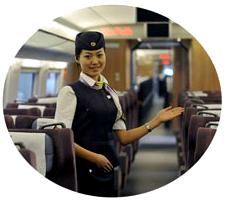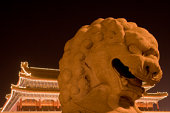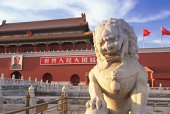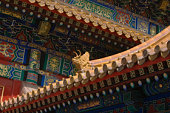|
from the Bund to China's Former
Capital to Today's Capital
7-day Shanghai-Nanjing-Beijing
Impression Tour
Experience the best of
China, both old and new!
Highlights:
• See the highlights of Shanghai, one
of the world’s great cities
• Experience China's fastest bullet train from Shanghai to Nanjing. Tour
Nanjing, the "Southern Capital" in comparison with Beijing, "the
Northern Capital" and the Capital of China before 1949, a city
of cultural and political center of six dynasties in China's
history
• See the wonders of Beijing,
China’s capital and most important city
B=(Breakfast) L=(lunch) D=(dinner) DEPARTURE: Daily
Package Price
Price is based on the time of
travel and number of customers. Please inquire through the form
on the left side of the page, we'll quote the best price we can
get. As this tour package involves domestic transfers, the
package price will vary from time to time because of the
changing airfares and hotel rates. |
|
| |
TOUR ITINERARY |
 |
Tour
code:
EXSHNJBJ |
|
Day 1: Airport
Transfer
Our English-speaking guide will pick you up from the
airport, and from there drive you directly to your
hotel, the Courtyard by Marriott Hotel, a 4.5 star
hotel located in central Shanghai. The rest of the
day is a free day, and you can spend it at your
discretion. |
Day 2: Shanghai
sightseeing (B/L)
Morning
After breakfast at the hotel, you will visit the Yuyuan Garden, a world-famous classical garden.
Yuyuan Garden occupies an area of 20,000 square
meters (about five acres). However, the small size
is not a representative of the attractions of the
garden. The pavilions, halls, rockeries, ponds and
cloisters all have unique characteristics. There are
six main scenic areas in the garden: Sansui Hall,
Wanhua Chamber, Dianchun Hall, Huijing Hall, Yuhua
Hall and the Inner Garden. Each area features
several scenic spots within its borders.
Then we will pay a visit to Shanghai Old Street.
Hidden behind the modern tall buildings and deep in
those squiggly lanes and bystreets where the old
fashioned living ways of Shanghai people still
exist, Shanghai Old Street southwest of Yuyuan
Garden is the one most worth visiting to find the
old culture and customs. The street is over a
hundred years old. The earliest private banks,
jewelry stores, opera towers, hongs, taverns and
teahouses in Shanghai were here originally. The
restaurants, opera towers and teahouses are the
definite highlights in the old street.
Afternoon
After experiencing the charm of the old street, we
will take a time machine from old Shanghai into the
city’s glittering present and future, which the Jin
Mao Tower is a prime example. Being the fourth
tallest building of the world and the second tallest
building in China, Jin Mao Tower is located in the
center of Lujiazui Finance and Trade Districts in
Pudong. The architect, Adrian D. Smith, of this
skyscraper ingeniously combined the elements of
traditional Chinese culture with the newest
architectural styles of the time, which makes Jin
Mao Tower one of the best-constructed buildings in
China. The tower’s observation decks give you an
almost bird’s eye view of the city’s rapidly rising
skyline.
The Shanghai Museum our next stop today, is a large
museum of ancient Chinese art. The museum style and
presentation surround visitors with artifacts
demonstrating ancient wisdom and philosophy. The
exterior design of the round dome and the square
base symbolizes the ancient idea of a round heaven
and a square land. The museum is divided into eleven
galleries and three exhibition halls. The eleven
Galleries cover most of the major categories of
Chinese art: Ancient Bronze, Ancient Ceramics,
Paintings, Calligraphy, Ancient Sculpture, Ancient
Jade, Coins, Ming and Qing Furniture, Seals, and
Minority Nationalities. The museum is a wonderful
primer on ancient Chinese culture, and is a must-see
when coming to Shanghai.
Our next destination today is the jade Buddah
Temple. In 1882, an old temple was built to keep two
jade Buddha statues which had been brought from
Burma by a monk named Huigen. The temple was
destroyed during the revolution that overthrew the
Qing Dynasty. Fortunately the jade Buddha statues
were saved and a new temple was built on the present
site in 1928. It was named the Jade Buddha Temple.
Although the history of the Jade Buddha Temple is
not very long, the old-time and classical
architectural style makes the temple unique and
inimitable in this modern city.
Your first full day in Shanghai will conclude with a
walk down Nanjing Road, Shanghai’s premier shopping
street. Open-air bars, abstract sculptures, and
lingering sounds from street musicians enhance
evening strolls. A trackless sightseeing train
provides a comfortable tour of the night-transformed
pedestrian street. Flashing neon signs illuminate
the magnificent buildings and spangle the night
skyline of this lively city. |
Day 3: Nanjing
tour sightseeing (B/L)
Morning
 After breakfast we will take a
China's
high-speed bullet express train to China's former capital of
Nanjing for only 1 hour and 13 minutes. You'll experience China's world-leading
express train technology which is now participating
in the bidding of U.S. California Intro-State Highspeed Railroad Project. Your local English-speaking guide will meet
you wherever you arrive. For your stay in Nanjing
you’ll be lodging at a 3 or 4 star hotel (for normal
tours) or a 5 star hotel (for deluxe tours). After breakfast we will take a
China's
high-speed bullet express train to China's former capital of
Nanjing for only 1 hour and 13 minutes. You'll experience China's world-leading
express train technology which is now participating
in the bidding of U.S. California Intro-State Highspeed Railroad Project. Your local English-speaking guide will meet
you wherever you arrive. For your stay in Nanjing
you’ll be lodging at a 3 or 4 star hotel (for normal
tours) or a 5 star hotel (for deluxe tours).
After allowing you to unpack and relax for a bit,
we’ll start your touring of the city with a visit to
the Yangtze River Bridge. The Great Bridge over the
Yangtze River in Nanjing is not only a striking
example of post-Revolutionary art and engineering,
but the story behind it is a source of pride for
people throughout China, and especially those in
Nanjing. It is the first modern bridge completely
built by Chinese people. After the 1949 Revolution,
China worked closely with the Soviet Union, and the
Soviets provided many technical advisors and
engineers.
Unfortunately, relations between the two countries
deteriorated in the early 1960's, and the USSR
brought all of its engineers home. Unwilling to give
up, Chinese engineers managed to overcome the
challenge and create this monumental and impressive
bridge. The huge piers of the bridge are capped with
towers topped by giant glass sculptures representing
red flags surging forward, vividly recording the
enthusiasm and patriotism of 1960's China.
Morning
After lunch, we’ll go to Nanjing’s most famed
landmark, and a favorite among foreign travelers, the Mausoluem of Dr. Sun Yat Sen (also known as
Zhongshan Ling). Dr. Sun was the first president of
the Republic of China and one of the leading
organizers of the struggle to create a modern
republic in China. The impressive memorial was built
in the 1920's. Its architecture is accentuated by
its splendid natural setting on the forested slopes
of Zijin Mountain on the outskirts of Nanjing, its
buildings made of white stone with dark blue roof
tiles.
Next we will go for a leisurely walk along Xuanwu
Lake. Situated at the foot of Mt. Zhongshan, Xuanwu
Lake is a beautiful scenic spot as well as
containing one of the three most famous lakes in
Nanjing. The history of Xuanwu can be traced back to
the Pre-Qin perio (21stcentury BC-221BC). According
to legend, in the Southern Dynasty a black dragon
was seen in the lake. Chinese Daoists believed that
the black dragon appeared as the uniform of a turtle
and snake, called Xuanwu. Hence, the lake was called
Xuanwu Lake. Another legend stated that when Sun
Quan, the King of Eastern Wu Kingdom settled down in
the region, he brought water in and made this lake.
Geological studies show that the lake was actually
formed by the movements of the geological plates
when Mt. Yanshan was formed.
In the long history of China, the lake has been used
by many dynasties as an ideal place to train their
waterborne troops. Many military demonstrations had
been held here and a lot of battles were fought
here. Therefore, the lake was also called “Military
Rehearsal Lake” or “Kunming Lake”. At the end of the
Qing Dynasty, the lake was turned into a park.
Today, the lake is much more beautiful with its
water and colorful mountains.
We’ll cap off our sightseeing with a visit to that
great sage Confucius, at his temple. Confucius (Kong
Fuzi) who taught philosophy in China 2,500 years ago
is considered the most important figure in the
shaping of ancient Chinese civilization as well as
the cultures of the countries of Japan, Vietnam, and
Korea. The Confucius Temple is south of the city’s
central district. There was a temple that was built
in the year 1034 during the Song Dynasty period on
the banks of the Qinhuai River. During the past
millennium, it was renovated, reconstructed, and
enlarged so that it became a large complex. It was
used by Confucian scholars. Next to it was the
Jiangnan Gongyuan that was the largest examination
area for people taking the imperial examinations and
the Xue Gong that was the Qing Imperial Academy for
training mandarins to govern the vast empire.
For dinner, we will go to a local restaurant, and
you can try a meal of Jiangsu cuisine, named after
the province Nanjing is located in, and the
specialty of the region.
We'll then take you back to check-in our #1 pick of
best hotels in Nanjing - Nanjing Holiday Inn - Aqua City and have a nice
sleep!
|
Day 4:
Nanjing-Beijing (B/L) by air
Morning
After breakfast, you will be driven to the Nanjing airport
for your flight to Beijing. Upon arrival, you will
be met by our English-speaking guide and taken to
your centrally located 5 star hotel.
Afternoon
Your first stop on your tour of Beijing will be Tiananmen Square. The largest public square in the
world, Tiananmen Square is seen as China’s political
center. Its grounds have seen some turbulent
moments, from the May 4th Movement of 1919 to the
political turmoil of 1989. The south of the square
is marked by the Chairman Mao Memorial Hall, while
the center of the square is dominated by the
Monument to the People’s Heroes, an imposing
10-story granite obelisk. To the east is the
National Museum of China, and to the west is the
Great Hall of the People, home to China’s
legislative bodies. The north of the square is
contains the Gate of Heavenly Peace, known for its
iconic portrait of Mao Zedong, and is the national
emblem of China.
After walking across the square we will enter the Forbidden City (known in Chinese as Gu Gong), the
largest surviving palace complex and the former home
of the emperors of the Ming and Qing Dynasty. The
Forbidden City is one of the greatest attractions in
the world. Built by the third Ming emperor between
1406-1422, the Forbidden City served as the official
residence to the Emperor of China until the last
emperor, Puyi, was forced to evacuate in 1924. The
Forbidden City is divided into two parts. The
southern section, or the Outer Court was where the
emperor exercised his supreme power over the nation.
The northern section, or the Inner Court was where
he lived with his royal family. Consisting of 980
buildings and with 8,707 bays of rooms, the
Forbidden City is the best example of classical
Chinese architecture in the world, and is a wonder
to behold.
You will then be driven back to your hotel, with
your evening at your discretion. |
Day 5: Beijing
sightseeing (B/L)
Morning
After a morning pickup at your hotel we will drive
directly to the Great Wall at Mutianyu. As one of
the best-preserved parts of the Great Wall, the
Mutianyu section of the Great Wall used to serve as
the northern barrier defending the capital and the
imperial tombs. First built in the mid-6th century
during the Northern Qi, Mutianyu Great Wall is older
than the Badaling section of the Great Wall. In the
Ming dynasty, under the supervision of General Xu Da,
construction of the present wall began on the
foundation of the wall of Northern Qi. In 1404, a
pass was built in the wall. In 1569, the Mutianyu
Great Wall was rebuilt and till today most parts of
it are well preserved.
Compared with other sections of Great Wall, the
Mutianyu Great Wall possesses unique characteristics
in its construction. Watchtowers are densely placed
along this section of the Great Wall - 22
watchtowers on this 2,250-meter-long stretch. The
Mutianyu Pass consists of 3 watchtowers, one big in
the center and two smaller on both sides. Standing
on the same terrace, the three watchtowers are
connected to each other inside and compose a rarely
seen structure among all sections of Great Wall.
While Mutianyu does get its fair share of visitors,
it does not get as packed as Badaling, allowing you
to have a peaceful time exploring the wall. After
walking around on Mutianyu, you have the option of
coming down via walking, taking a cable car, or
taking a toboggan ride (lots of fun and highly
recommended!). After meeting our minibus in the
parking lot, we will then head back to the city
center in the afternoon to the Olympic Green.
Afternoon
The Olympic Green was the center of the event that
captivated the world for two weeks in August of
2008. The highlights include the Bird’s Nest
(officially known as the Beijing National stadium)
and the Water Cube (the Beijing National Aquatics
Center). The stadium gets its nickname from its
outward design, which originated from the study of
Chinese ceramics, implementing steel beams in order
to hide supports for the retractable roof, thus
giving the stadium the appearance of a "Bird's
nest". The Bird’s Nest hosted the Opening and
Closing Ceremonies, athletic events, and football
final of the 2008 Summer Olympics, from 8 August to
24 August 2008. Since the Olympic end, the Bird’s
Nest has been used to host events from opera to a
ski park.
Despite its nickname, the Water Cube is not a cube
but a cuboid, (a rectangular box). The outer wall of
the building is based on the Weaire–Phelan
structure, a structure devised from the natural
formation of bubbles in soap foam. The complex
Weaire–Phelan pattern was developed by slicing
through bubbles in soap foam, resulting in more
irregular, organic patterns than foam bubble
structures proposed earlier by the scientist Kelvin.
The Water Cube hosted the swimming, diving, and
synchronized swimming events during the Olympics,
and was the sight of Michael Phelps’ record breaking
Olympic triumph.
You will then be driven back to your hotel with your
evening at your discretion. |
Day 6: Beijing
sightseeing (B/L)
Morning
After breakfast at your hotel you will be driven by
our guide to the Temple of Heaven park. The complex
was visited by the Emperors of the Ming and Qing
dynasties for annual ceremonies of prayer to Heaven
for good harvest. The Temple of Heaven park is best
known for the Hall of Prayer for Good Harvests, an
iconic building famed for its magnificent
triple-gabled circular roof. You will also have an
opportunity to walk the same imperial walkway that
the same emperors walked hundreds of years ago in
their holy rites. You will also see Beijing’s senior
citizens using the park grounds for everything from
tai chi and ballroom dancing to bullwhip practice!
After visiting the Temple of Heaven we will go to
visit the Lhama Temple. Other than the temples in
Tibet this is the best Buddhist temple in China.
Work on the Lhama Temple originally began in 1694
during the Qing dynasty. It served as an official
residence for court eunuchs. It was then converted
into the home of the Prince Yong, a son of the
Kangxi Emperor and himself the future Yongzheng
Emperor. It was converted into a lamasery after his
ascension to the throne in 1722. Today the Lhama
Temple still functions as a monastery and temple of
the Geluk School of Tibetan Buddhism. Walking
through the temple your senses will be enveloped by
the incenses and the chanting of the visiting monks
and other followers. The rear Pavilion of Ten
Thousand Happinesses features a 26m tall statue of
the Maitreya Buddha cared from a single piece of
white sandalwood. It is one of three artworks in the
Lhama Temple that were included in the Guiness Book
of World Records, and it is not to be missed on your
visit.
Afternoon
The last stop on your journey through China will be
at the Summer Palace. Having the largest royal park
and being well preserved, the Summer Palace is
ranked amongst the most noted and classical gardens
of the world. In 1998, UNESCO listed it as one of
the World Heritage Sites. Like most of the gardens
of Beijing, it could not elude the rampages of the
Anglo-French allied force of 1860 and was destroyed
by fire. In 1888, Empress Dowager Cixi embezzled
navy funds to reconstruct it for her own benefit,
changing its name to Summer Palace (Yiheyuan). She
spent most of her later years there, dealing with
state affairs and entertaining. Highlights not to be
missed are climbing Longevity Hill, viewing the
Empress Dowager Cixi’s extravagant Marble Boat, and
talking a walk down Suzhou jie, a canal meant to
resemble the river city of Suzhou. After visiting
Suzhou you will be able to compare the two and judge
its authenticity!
You will then be taken back to your hotel for the
evening. |
Day 7:
Beijing-home destination (B)
After breakfast you will be driven to the airport,
ending your stay in China. After all the amazing
sights and wonders you’ve seen you will have lots of
stories and pictures to show all your friends and
family! Maybe they will come back with you the next
time you visit! |
|
Tour Inclusions:
1. Hotels with daily western
breakfasts;
2. Meals in accordance with
that listed on the itinerary.
3. professional local guide
& driver;
4. Private air-conditioned
car or van for transportation;
5. Admission of the first
gate.
6.Two bottles of mineral
water per day.
Tour exclusions:
1. Tip of the guide
2. Personal costs
    |
|

